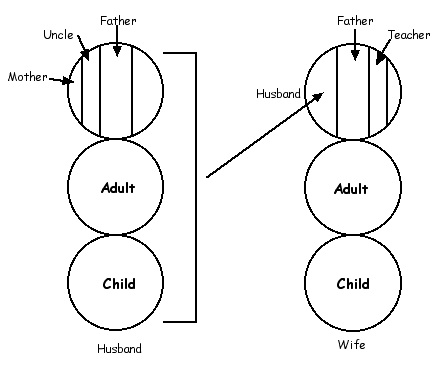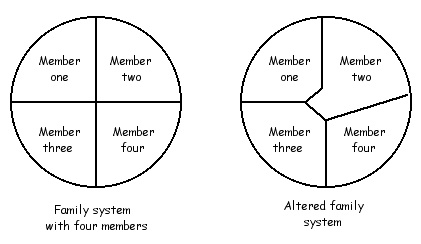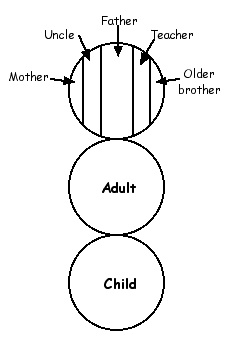In relationships of any depth there is a natural tendency for both parties over time to become more the same. They will tend to become more like one another.
When any two people spend time together they will tend to model and introject each other. This is inevitable and indiscriminate and can not be avoided. Humans will instinctively do it whether they are aware of it or not.
This process is easily explained in transactional analysis

This shows how the wife models or introjects her husband’s personality into her own Parent ego state and of course he does the same with her over time. As mentioned before this process can not be avoided and will happen instinctively.
The copying relates to the behaviour, thoughts, attitudes and feelings of the other. All these parts of the others personality become our own after time. However husbands and wives do not end up as clones of each other and they do remain different over time. Of course the Parent ego state is but just one aspect of the personality and we all also have an Adult and Child ego state and these can be quite different between the two partners. However there is a tendency to sameness in the way described and this does not have to be an equal process.

Modeling can even occur between animal and human
People will tend to model more on those who are of more perceived potency and emotional importance. Thus the introjection between the married couple may be at different degrees. That is, one does more introjection than the other and generally speaking it is the more dominant party in the relationship who will be introjected more than the other way around.
This has been studied in some depth before and is presented in the DSM-IV by the American Psychiatric Association (1994) who discuss the Folie a Deux or a shared delusional disorder. In this case two people who are in a close relationship over time develop the same delusional belief system. There tends to be one dominant party and the more submissive party takes on the delusion of the other. This means that should the relationship end the more submissive party will tend to drop the delusion over time even though the submissive party probably has a tendency to have the same delusional beliefs.
Of course they don’t have to be delusional beliefs but can be beliefs or views about anything including religious views, political views, attitudes to neighbours, relatives, friends and so forth.

It should be noted that even after the introjection has taken place there are other potent psychological processes at work that further develop the sameness in a couple. The most obvious example of this is the phenomena of group think. In this situation when two or more people get together there is internal pressure in the group towards uniformity which leads the group to come up with same consensus that maybe false or not.
Group think can result in:
Illusion of invulnerability that can encourage excessive optimism and risk taking
Unquestioned belief in the group’s morality and goals which can result in the group members ignoring the consequences of their actions
Self censorship of deviations in the group’s beliefs and goals
Suppression of dissent by more powerful members in the group
Feelings of anonymity
Discount self responsibility
As two people talk and discover that they tend to have the same attitude or opinion about something this can give them a false sense of security as is described above. “If others think the same as I do then that makes my views more correct or right” is the reasoning behind group think. Thus if a husband and wife have introjected similar views from the other about something, group think can play a part in further fostering the sameness.

Most often this does not matter all that much if they are political views, religious views or dislike for their next door neighbours. However if the views will tend to incite racial hostility or religious persecution then there is a much more serious problem.
This can also involve similar views about suicide. That is, views like suicide is an OK solution to a problem, everyone has the right to choose and so forth. If they have introjected these from each other and then have a sense of group think, in extreme cases one can end up with the suicide pact. Both parties agree to suicide at the same time.
Even if there is no suicide pact it will make suicide a more easy choice for one of the parties in the relationship for the reasons just mentioned. Thus in working with the suicidal it is instructive to make an assessment of the relationships that the suicidal individual is involved at that time to see if any of these psychological processes are at work.
Graffiti


























